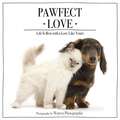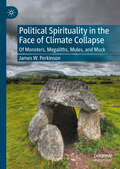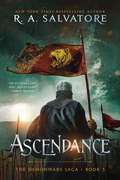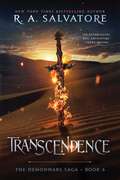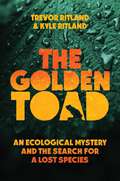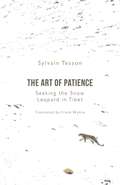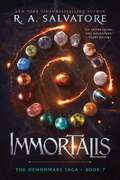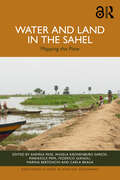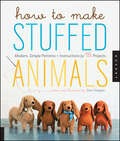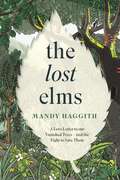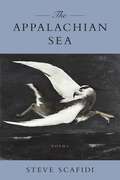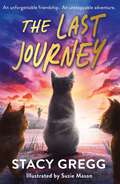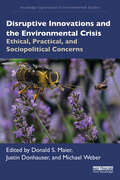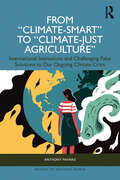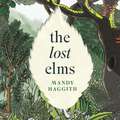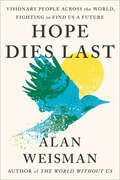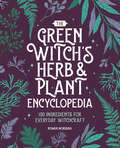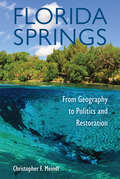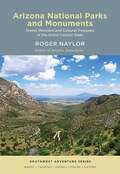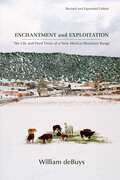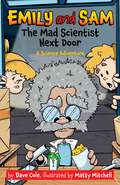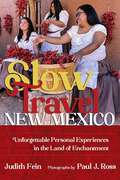- Table View
- List View
Pawfect Love: Life Is Best with a Love Like Yours (Perfect for Animal Lovers)
by ZondervanPawfect Love combines adorable photos of unlikely animal pairs with affectionate quotes to share with the one you love--differences and all! With over 150 pages of fur-cuteness, grown-ups and kids will love this coffee table book. From a bunny snuggling with a duck to a kitty playing with a deer to a puppy having fun with a hamster, these furry pairs remind us that not being exactly the same is part of what makes a relationship great.Spotlighting topics such as commitment, happiness, and togetherness, the quotes are by an array of beloved writers, such as:C.S. LewisKatharine HepburnDonald MillerCharles DickensCharlotte BronteOscar Wildeand many more Delightful photos from the mother-son photography team Warren Photographic humorously communicate the lighter side of your heart's affection in this fun and unique gift book. Pawfect Love is a fun gift for:Couples on their engagement, wedding day, or anniversaryA significant other on Valentine's Day, a birthday, or any ordinary dayPeople who love animals and animal photography One of the best things about love is enjoying each other's uniqueness. Our animal friends have discovered this already! So here's to our differences! We wouldn't want it any other way--paws down.
Political Spirituality in the Face of Climate Collapse: Of Monsters, Megaliths, Mules, and Muck
by James W. PerkinsonThis book takes its motive force from our contemporary climate crisis. It seeks to reorient human (and especially Christian) understanding, towards a more ecologically-focused, indigenously-informed way-of-living. James W. Perkinson argues that our current eco-climatic and socio-political emergency is the culmination of a 5,000-year history of supremacist “settlement,” in which city-states first emergent in Mesopotamia and Egypt not only begin coercively organizing labor into surplus production and ecosystems into inordinate and destructive yields of “goods,” but in the process, also simultaneously “deform” the Spirit-World “haloing” of natural phenomenon into outsized service of imperial reach. Perkinson recognizes globalized humanity as an emerging monstrosity destroying both human culture and the world. How we re-envision and revalue, at our critical juncture, our inescapable interdependence with the more-than-human world as peer and teacher and even “elder,” is the central theme that throbs below the surface of the very disparate topics commanding attention in each chapter.
Ascendance: The DemonWars Saga, Book 5 (DemonWars series #5)
by R. A. SalvatoreYears have passed since the great miracle atop Mount Aida, and Corona is a different place—yet a threat looms, one Kilseponie could never have anticipated in this next installment in the DemonWars series from bestselling author R. A. Salvatore.Much to the seething dismay of his long-time mistress, King Danube has asked Julsepnie Wyndon to become his queen. But she is torn. How can she love any man as completely as she did the Ranger Elbryan, the father of the child she lost? But unknown to Jilseponie, that child never died. Aydrian was stolen away by the queen of the elves. A headstrong boy secretly raised to be a weapon, Aydrian shows great promise in the arts of combat, and he is as powerful with the gemstone as his mother. Now, De&’Unnero, the weretiger and mortal enemy of Jilseponie, will join forces with Aydrian, who is hungry for power and on a collision course with destiny. Building upon the events in Mortalis, #1 New York Times bestselling author R.A. Salvatore continues the fresh second trilogy within the DemonWars saga with his fifth book in the series.
Transcendence: The DemonWars Saga, Book 6 (DemonWars series #6)
by R. A. SalvatoreThe next novel in bestselling author R.A. Salvatore&’s second DemonWars saga, Transcendence is an extraordinary adventure that introduces a remarkable new hero—and explores the mysteries of enlightenment and the art of war in a dazzling epic of imagination.Brave and beautiful Brynn Dharielle has ventured on a daring mission to free her beloved homeland from tyrannical rule. But she cannot imagine the depths of chaos and betrayal that seethes amid a ruthless sect of warrior priests led by an evil chieftain who conceals a dark, age-old secret. For Brynn and her trusted elven companion, the way to Behren turns into a fierce and illuminating voyage. But by the time Brynn reaches the land where she once saw her parents murdered, the seeds of revolution are already flourishing. The first salvo of a sweeping battle has begun—one that will threaten to destroy the heart and soul of her world. In book six of the DemonWars saga, #1 New York Times bestselling author R.A. Salvatore continues the second trilogy of the saga in what Booklist raves &“outstanding…Brynn Dharielle is a first-rate female high-fantasy protagonist.&”
The Golden Toad: An Ecological Mystery and the Search for a Lost Species
by Trevor Ritland Kyle RitlandThe Costa Rican cloud forest, a mysterious amphibian killer, and a vanished species: with support from Leonardo DiCaprio&’s Re:wild campaign, twin documentarians and environmental writers follow their father&’s footsteps into the heart of the modern extinction crisis. As young boys, Trevor and Kyle Ritland were fascinated by the magnificent golden toad of Costa Rica, a brilliant species their biologist father showed them in his projector&’s slide shows. Native to only one wind-battered ridgeline high on the continental divide above the cloud forests of Monteverde, thousands of golden toads would congregate for a few weeks each year in ephemeral pools among the twisted roots to mate, deposit their offspring, and retreat again beneath the earth. But from one year to the next, the toads disappeared without a trace; the last of them vanished more than thirty years ago. Since then, only rumors remain—alleged sightings by local residents, which beg the question: could the golden toad still be alive? In The Golden Toad, Trevor and Kyle set off to investigate an environmental mystery with unexpected revelations, a story that speaks to our own collective and uncertain future. Guided by Costa Rican naturalists—including the last person to have seen the golden toad alive—Trevor searches for survivors while Kyle hunts the killer, and their paths lead them through an imperiled forest, a deadly pandemic, and a changing climate, finally intertwining at the site of the golden toad&’s last emergence deep in Monteverde&’s Bosque Eterno de Los Niños. The toad&’s demise becomes a haunting foretelling of approaching ecological crisis, but with a gold lining on the horizon. The Golden Toad changes the conversation around extinction, climate change, and conservation while exploring environmental grief, resurrection, and hope in a changing world.
The Art of Patience: Seeking the Snow Leopard in Tibet
by Sylvain TessonWinner of the Prix Renaudot 2019 A New York Times Best Book of 2021 &‘Extraordinarily beautiful… a long last loving glance at the planet.&’ Carl Safina, author of Becoming Wild The Art of Patience sees the renowned French adventurer and writer set off for the high plateaux of remotest Tibet in search of the elusive snow leopard. There, in the company of leading wildlife photographer Vincent Munier and two companions, at 5,000 metres and in temperatures of -25ºC, the team set up their hides on exposed mountainsides, and occasionally in the luxury of an icy cave, to await a visitation from the almost mythical beast. This tightly focused and tautly written narrative is simultaneously a dazzling account of an exacting journey, an apprenticeship in the art of patience, an acceptance of the ruthlessness of the natural world and, finally, a plea for ecological sanity. A small masterpiece, it is one of those books that demands to be read again and again.
Immortalis: The DemonWars Saga, Book 7 (DemonWars series #7)
by R. A. SalvatoreIn this extraordinary third and final work in the second DemonWars trilogy, R. A. Salvatore weaves a diverse tapestry of characters and events from all novels of the series into an epic, unforgettable conclusion as a dark young king is driven by a quest to remake humankind.In Honce-the-Bear, King Aydrian Boudabras wakes in a cold sweat, his conscience haunted by those he has killed in order to garner power, including the rightful king before him, Danube, his mother&’s husband. Now, Aydrian is preparing his armies for war, forging loyalties, playing one adversary against another, and giving those around him barely a glimpse at his remarkable powers. In the neighboring Behren, the evil Yatol Bardoh is unleashing a war engine of his own, using armies of mercenaries and horrific tactics to bring down the walls of Jacintha and to drive a ferocious dragon from the city of Dharyan. Between these two men, an explosive chain of events has been set into motion. Refugees flood the roads and valleys, alliances are formed and broken, navies clash at sea, and assassins seek their moment to strike. With Aydrian&’s power and popularity turning into an avalanche and the courageous Byrnn Dharielle valiantly standing in the way of the Yalot Bardoh, the great players in the DemonWars saga will unite and clash on a single, magnificent stage. In book three of the second DemonWars trilogy, #1 New York Times bestselling author R. A. Salvatore concludes the second trilogy and gathers the whole arc of the seven books of the DemonWars saga in a stunning conclusion that Kirkus Reviews claims &“fans will dance with joy&” to experience.
Water and Land in the Sahel: Mapping the Flow (Routledge Studies in African Geography)
by Angela Kronenburg García Andrea Pase Mariasole Pepa Federico Gianoli Marina Bertoncin Carla BragaDrawing on over thirty years of research, this book investigates the intermingling of land and water in the Sahel, analysing landscapes defined by the ebb and flow of rainfall, flooding and population movements, as well as environmental, political and social crises.Exploring both the seasonal flooding of rivers around the Nile, Chari-Logone, Niger and Senegal, as well as agricultural irrigation projects such as dams, canals and pumping stations, the book examines the different narratives related to water and land in the Sahel. It combines fieldwork research with remote sensing, big data and GIS mapping to outline the ever-changing interplay between land and water in the region. Beyond this, the book also reinterprets the colonial and post-colonial legacies of large-scale irrigation projects and the geopolitical interests which defined them.Supported by an Open Access website with a WebGIS and further maps and analysis, this book is an essential read for policy makers and development practitioners in the region, as well as for researchers and scholars across the fields of geography, history, political science, sustainable development and African studies.The Open Access version of this book, available at www.taylorfrancis.com, has been made available under a Creative Commons Attribution-No Derivatives (CC-BY-ND) 4.0 license.
Doppelganger: A Trip into the Mirror World
by Naomi Klein#1 NATIONAL BESTELLER • Winner of the 2024 Women's Prize for Non-Fiction • Winner of the 2024 Vine National Canadian Jewish Book Award for Non-Fiction • Finalist for the 2024 National Book Critics Circle Award for Criticism • Shortlisted for the 2024 Hubert Evans Non-Fiction Prize • A New York Times Notable Book of 2023 • Vulture&’s #1 Book of 2023 • A Guardian Best Ideas Book of 2023What if you woke up one morning and found you'd acquired another self—a double who was almost you and yet not you at all? What if that double shared many of your preoccupations but, in a twisted, upside-down way, furthered the very causes you'd devoted your life to fighting against?Not long ago, Naomi Klein had just such an experience—she was confronted with a doppelganger whose views she found abhorrent but whose name and public persona were similar enough to her own that many people confused her for the other. For a vertiginous moment, she lost her bearings. And then she got interested, in a reality that seems to be warping and doubling like a digital hall of mirrors. It&’s happening in our politics as New Age wellness entrepreneurs turned anti-vaxxers find common cause with fire-breathing far right propagandists (all in the name of protecting &“the children&”). It&’s happening in our culture as AI gobbles up music, paintings, fiction and everything in between and spits out imitations that threaten to overtake the originals. And it&’s happening to many of us as individuals as we create digital doubles of ourselves, filtered and curated just so for all the other duplicates to see. An award-winning journalist, bestselling author, public intellectual and activist, Naomi Klein writes books that orient us in our time. She has offered essential accounts of what branding, austerity, and climate profiteering have done to our societies and souls. Now, as liberal democracies teeter on the edge, Klein takes aim at absurdist authoritarianism, using a keen sense of the ridiculous to face the doubles that haunt us. Part tragicomic memoir, part chilling reportage and cobweb-clearing analysis, Doppelganger invites readers on a wild ride, smashing through the mirror world, charting a path beyond despair towards true solidarity.
How to Make Stuffed Animals: Modern, Simple Patterns + Instructions for 18 Projects
by Sian KeeganLearn how to make eighteen stuffed animal projects with original sewing patterns and illustrated instructions from this easy-to-use craft guide.With a complete overview of techniques and materials, How to Make Stuffed Animals shows that making these cuddly creatures is fun, addictive, and much easier than one would think. Anyone who has completed the most basic of sewing projects can master the projects in this book, and these cute creations can be used as decorative objects for the home or as great handmade gifts.Inside, you’ll find adorable animals like:A squirrel holding an acornA grizzly bearA raccoonA horseA bird mobileCute caninesFurry felinesAnd many moreExplore a comprehensive range of animals in a modern and simple style with How to Make Stuffed Animals!
The Lost Elms: The stunning new nature book from the 'unofficial poet laureate of our woodlands'
by Dr Mandy Haggith'Unofficial poet laureate of our woodlands.' - THE SCOTSMAN'Not just an elegy to our lost elms but also a meditation on life, culture and trees.' - FRED PEARCEFor millennia, elms shaped our landscape and our folklore; then they started dying.For the past century, a deadly pandemic has raged across the world, destroying all in its path and outmanoeuvring scientists' desperate attempts to halt it.Dutch elm disease has killed hundreds of millions of trees globally and over 25 million in the UK alone, altering our landscapes forever. Few young people have seen a mature elm tree, yet they once covered great swathes of Europe and North America and their legacy lives on in our mythology.The Lost Elms is a love letter to our vanished elms - the story of how we have nearly lost them all, and the long, slow fight back. It tells the gripping story of the scientists desperately trying to halt the disease's relentless progress, and demonstrates the deadly effect globalisation can have on the environment, the threat of climate change, the importance of biosecurity and the intricate ways in which trees are interlinked with other species. Woven throughout is a lyrical look at the elm's central place in our history, culture and folklore - the elm features heavily in Greek, Celtic, Japanese, Germanic and Scandinavian mythology; as the 'Liberty Tree' it played a symbolic role in both the American and French Revolutions; and since ancient times the elm has held associations with death and the supernatural.However all is not lost: recent breakthroughs in ecological understanding reveal elms to be far more resilient than we ever imagined. This tree holds an important place in our history, and now might just offer hopeful lessons for how we can save other disappearing species and our environment.
The Lost Elms: The stunning new nature book from the 'unofficial poet laureate of our woodlands'
by Dr Mandy Haggith'Unofficial poet laureate of our woodlands.' - THE SCOTSMAN'Not just an elegy to our lost elms but also a meditation on life, culture and trees.' - FRED PEARCEFor millennia, elms shaped our landscape and our folklore; then they started dying.For the past century, a deadly pandemic has raged across the world, destroying all in its path and outmanoeuvring scientists' desperate attempts to halt it.Dutch elm disease has killed hundreds of millions of trees globally and over 25 million in the UK alone, altering our landscapes forever. Few young people have seen a mature elm tree, yet they once covered great swathes of Europe and North America and their legacy lives on in our mythology.The Lost Elms is a love letter to our vanished elms - the story of how we have nearly lost them all, and the long, slow fight back. It tells the gripping story of the scientists desperately trying to halt the disease's relentless progress, and demonstrates the deadly effect globalisation can have on the environment, the threat of climate change, the importance of biosecurity and the intricate ways in which trees are interlinked with other species. Woven throughout is a lyrical look at the elm's central place in our history, culture and folklore - the elm features heavily in Greek, Celtic, Japanese, Germanic and Scandinavian mythology; as the 'Liberty Tree' it played a symbolic role in both the American and French Revolutions; and since ancient times the elm has held associations with death and the supernatural.However all is not lost: recent breakthroughs in ecological understanding reveal elms to be far more resilient than we ever imagined. This tree holds an important place in our history, and now might just offer hopeful lessons for how we can save other disappearing species and our environment.
The Appalachian Sea: Poems (Southern Messenger Poets)
by Steve ScafidiSteve Scafidi’s The Appalachian Sea explores the eponymous place of mountains and story, of rivers and magic, as well as of mortality, where people work and live and die. What began as an homage to the American painter Miles Cleveland Goodwin became a celebration of the spectral qualities of place and home. The artist’s gothic imagery of haints and dark orchards haunts the book, wherein the Shenandoah wends, old farmers toil, and ghosts wander a land where change comes on like a flood. There is no escape from this spilling river, the “Appalachian sea,” yet for a while we get by and survive. These poems sing of the temporary persistence that makes what surrounds us beloved and strange.
The Last Journey
by Stacy GreggBeautiful and heart-achingly sad animal adventure with CATS and a strong environmental message. Perfect for fans of Michael Morpurgo, Sarah Lean and Hannah Gold's The Last Bear...&‘Captures the magic that animals bring to our lives.&’ Sarah Ann Juckes, author of The Night Animals Pusskin has always lived with his loving owner, eleven-year-old Lottie. The bond between them is unbreakable, or so they both thought. But when the bird and insect populations are depleted, cats are made a scapegoat. Keen to protect his cat friends on the cul-de-sac, Pusskin sets off on a journey that will take them to a hidden island at the furthest reaches of the country. When Lottie tries to bring him home, she soon comes to realise that for Pusskin to have any chance of survival, she&’ll have to let him go. Could this be their final goodbye?
Disruptive Innovations and the Environmental Crisis: Ethical, Practical, and Sociopolitical Concerns (Routledge Explorations in Environmental Studies)
by Michael Weber Donald S. Maier Justin DonhauserThis book probes the ethical, practical, and sociopolitical implications of leveraging innovative and disruptive means to address the world’s various environmental crises.Packed with keen observations and analyses, the volume brings together research from seasoned scholars and rising stars to cast important new light on urgent issues engendered by humankind’s disruption of environments, such as climate change and biodiversity loss. It tackles the question of exactly what has been disrupted in the world—environmentally, economically, socially, and politically. It also examines an assortment of innovative interventions that aim to address disruptions and explores the question of what further disruptions may lurk behind assorted innovative interventions intended to address already existing disruptions. Chapters wrestle with the social, ethical, and ecological implications of disruptions, both pre-existing and those brought about by interventions, connected with deploying artificial gene drives, substituting robotic pollinators for living ones, synthesizing organisms to replace ones lost, installing economic regimes that work well for both citizens and the environment, making science subservient to non-scientific commitments, involving citizens in environmentally consequential decisions, choosing scientific and technological projects that most promise immediate practical payoff, and ensuring that respect for human rights is part and parcel of any technology-infused project. These discussions draw on a rich mix of science, philosophy of science, political theory, economics, sociology, network theory, ethics, and theories of justice and human rights.This book will be of great interest to students and scholars of environmental science, environmental decision-making, ecology, climate change, environmental philosophy, and the philosophy of science.
From "Climate-Smart" to "Climate-Just Agriculture”: International Institutions and Challenging False Solutions to our Ongoing Climate Crisis (Bridges to Another World)
by Anthony PahnkeCombining innovative social theory with ongoing policy discussions on climate change, this book analyzes past and present efforts at challenging global poverty through reforming the dynamics of worldwide agricultural production.Focusing on the efforts of the World Bank and CGIAR research centers, particularly through research and projects that have been launched by the International Maize and Wheat Improvement Center (CIMMYT) and the International Food Policy Research Institute (IFPRI), “Climate-Smart” to “Climate-Just” exposes how neoliberal principles of limited government and individual entrepreneurship have expanded through the development of “Climate-Smart Agriculture.” At the same, an alternative – “Climate-Just Agriculture” – is becoming possible as rightwing populists have disrupted international free trade orthodoxy, and social movement demands for food sovereignty gain traction in key international spaces.As Pahnke explains in this innovative account, “Climate-Just Agriculture” includes structural changes to free trade agreements that would build from local and regional food systems to make them resilient in the face of the adverse effects of climate change. This resiliency, moreover, allows marginalized groups the capacity to create and participate in markets that allow for greater self-sufficiency to push back on colonialism and imperialism.Written in a clear and accessible style, this book will be essential reading for students and scholars of sociology, environmental studies, and politics, as well as for policymakers and professionals involved in climate change policy and the agriculture and food industry.
The Lost Elms: The stunning new nature book from the 'unofficial poet laureate of our woodlands'
by Dr Mandy Haggith'Unofficial poet laureate of our woodlands.' - THE SCOTSMAN'Not just an elegy to our lost elms but also a meditation on life, culture and trees.' - FRED PEARCEFor millennia, elms shaped our landscape and our folklore; then they started dying.For the past century, a deadly pandemic has raged across the world, destroying all in its path and outmanoeuvring scientists' desperate attempts to halt it.Dutch elm disease has killed hundreds of millions of trees globally and over 25 million in the UK alone, altering our landscapes forever. Few young people have seen a mature elm tree, yet they once covered great swathes of Europe and North America and their legacy lives on in our mythology.The Lost Elms is a love letter to our vanished elms - the story of how we have nearly lost them all, and the long, slow fight back. It tells the gripping story of the scientists desperately trying to halt the disease's relentless progress, and demonstrates the deadly effect globalisation can have on the environment, the threat of climate change, the importance of biosecurity and the intricate ways in which trees are interlinked with other species. Woven throughout is a lyrical look at the elm's central place in our history, culture and folklore - the elm features heavily in Greek, Celtic, Japanese, Germanic and Scandinavian mythology; as the 'Liberty Tree' it played a symbolic role in both the American and French Revolutions; and since ancient times the elm has held associations with death and the supernatural.However all is not lost: recent breakthroughs in ecological understanding reveal elms to be far more resilient than we ever imagined. This tree holds an important place in our history, and now might just offer hopeful lessons for how we can save other disappearing species and our environment.
Hope Dies Last: Visionary People Across the World, Fighting to Find Us a Future
by Alan WeismanOne of Heatmap's 18 Climate Books to Read in 2025The award-winning environmental journalist&’s extraordinary, long-awaited portrait of hope and resilience as we face a fractured and uncertain futureIn this profoundly human and moving narrative, the bestselling author of The World Without Us returns with a book ten years in the making: a study of what it means to be a human on the front lines of our planet&’s existential crisis. His new book, Hope Dies Last, is a literary evocation of our current predicament and the core resolve of our species against the most precarious odds we have ever faced.To write this book, Weisman traveled the globe, witnessing climate upheaval and other devastations, and meeting the people striving to mitigate and undo our past transgressions. From the flooding Marshall Islands to revived wetlands in Iraq, from the Netherlands and Bangladesh to the Korean DMZ and to cities and coastlines in the U.S. and around the world, he has encountered the best of humanity battling heat, hunger, rising tides, and imperiled nature. He profiles the innovations of big thinkers—engineers, scientists, conservationists, economists, architects, and artists—as they conjure wildly creative, imaginative responses to an uncertain, ominous future. At this unprecedented point in history, as our collective exploits on this planet may lead to our own undoing and we could be among the species marching toward extinction, they refuse to accept defeat.Hope Dies Last fills a crucial gap in the global conversation: Having reached a point of no return in our climate confrontation, how do we feel, behave, act, plan, and dream as we approach a future decidedly different from what we had expected?
The Green Witch's Herb and Plant Encyclopedia: 150 Ingredients for Everyday Witchcraft
by Rowan MorganaEverything you need to know about using plants and herbs for green witchcraftInfusing your craft with plants and herbs is a powerful way to connect to Mother Earth. This green witchcraft encyclopedia explores the most essential magical plants, offering you a complete resource for safely growing, foraging, harvesting, and using everything from aloe to valerian. Discover greater harmony with nature as you harness the natural energy of plants to create healing and balance in your life.150 plant profiles — Find detailed entries for the plants and herbs green witches use the most, including photos, explanations of each plant's magical properties, and tips for how to grow them yourself.Herb magic in action — Experience the power of plant magic with spells and rituals to try, such as banishing negativity with catnip and clover or building a fairy altar with foxglove and thyme.Embrace your inner witch — Part reference guide and part grimoire, this book of herbs helps you develop your practice by exploring how to set intentions, create a sacred space, and maintain your own garden.Start your own witch's apothecary and create some everyday magic with this encyclopedia of magical herbs and plants.
Florida Springs: From Geography to Politics and Restoration
by Christopher F. MeindlFlorida Book Awards, Gold Medal for Florida NonfictionAmerican Association of Geographers Globe Book Award for Public Understanding of GeographyAn indispensable resource for learning about the freshwater wonders of Florida Florida is home to over 1,000 freshwater springs, natural wonders that have drawn people to enjoy and interact with them over the course of millennia. This book provides a clear and comprehensive overview of the geography, history, science, and politics of the springs, informing readers about the deep past and current issues facing these treasures of the Florida landscape. Christopher Meindl explains the unique physical features of Florida’s springs, including the “swiss cheese” structure of the state’s aquifers and the complexities of its groundwater hydrology, providing helpful maps, graphs, and photos. Meindl discusses how ancient and modern people have used the springs—as centers of communities, therapeutic spas, roadside attractions, parks, and more. He addresses contemporary threats to the springs in areas such as water flow, water quality, and overcrowding. Finally, he explores recent state policies, the activism of environmentalists, and current and potential restoration projects that seek to prevent springs degradation. Meindl brings to light a struggle for truth among scientists, politicians, and businesspeople about the causes of problems the springs face today. Challenging oversimplified answers and looking at multiple hypotheses, Meindl raises intriguing questions that will inspire readers to join the ongoing discussion about how best to protect and restore Florida’s iconic freshwater sanctuaries.
Into the Great White Sands
by Craig VarjabedianPhotographic masterpiece on beloved White Sands National Park; now in paperback. Winner of the New Mexico-Arizona Book Award for Photography. Like Ansel Adams in a contemporary and pristine setting. Powerfully relevant today.Award-winning photographer Craig Varjabedian has spent decades photographing the many moods of the magnificent and ever-changing landscape of New Mexico&’s White Sands National Monument. His photographs reveal snow-white dunes of gypsum, striking landforms, storms and stillness, panoramic vistas and breathtaking sunsets, intricate wind-blown patterns in the sand, ancient animal tracks, exquisite desert plants, and also the people who come to experience this place that is at once spectacular yet subtle. Varjabedian&’s evocative color images provide the reader with an almost palpable sense of this extraordinary place.These photographs are enriched by several essays written by Jeanetta Calhoun Mish, noted poet and author; Dennis Ditmanson, retired White Sands National Monument superintendent; Jim Eckles, retired Missile Range public affairs officer; and Craig Varjabedian, the photographer who shares his insights and experiences of photographing this inspiring landscape and offers tips on making better pictures of White Sands.
Arizona National Parks and Monuments: Scenic Wonders and Cultural Treasures of the Grand Canyon State (Southwest Adventure Series)
by Roger NaylorArizona’s national parks and monuments range from places of staggering natural beauty to ancient historic sites. They are spread throughout the state, featuring deserts, mountains, sparkling lakes and rivers, canyons, a forest of fossilized trees, and dazzling cliffs and rock formations. The historic parks reveal Arizona’s past, dating back to the Ancestral Puebloan villages and their rock art. There are Spanish missions, old west forts, Mormon forts, stagecoach routes, and a still-operating trading post that has barely changed in 150 years.Featuring ninety color photographs and maps, Arizona National Parks and Monuments details all thirty-four destinations with an overview of what makes each park unique, a thorough description and history, and information about hiking trails, camping, boating, fishing, tours, and more.A perfect companion volume to his bestselling Arizona State Parks, Roger Naylor’s Arizona National Parks and Monuments is the essential guide to curating your unique Arizona experience, written by “the dean of Arizona travel writers.”
Enchantment and Exploitation: The Life and Hard Times of a New Mexico Mountain Range, Revised and Expanded Edition
by William deBuysFirst published in 1985, William deBuys&’s Enchantment and Exploitation has become a New Mexico classic. It offers a complete account of the relationship between society and environment in the Sangre de Cristo Mountains of northern New Mexico, a region unique in its rich combination of ecological and cultural diversity. Now, more than thirty years later, this revised and expanded edition provides a long-awaited assessment of the quality of the journey that New Mexican society has traveled in that time—and continues to travel.In a new final chapter deBuys examines ongoing transformations in the mountains&’ natural systems—including, most notably, developments related to wildfires—with significant implications for both the land and the people who depend on it. As the climate absorbs the effects of an industrial society, deBuys argues, we can no longer expect the environmental future to be a reiteration of the environmental past.
The Mad Scientist Next Door (Emily and Sam)
by David ColeA new mystery unfolds when Emily and Sam get a new neighbor!Emily and Sam are excited to see a moving van next door, but the new neighbor isn't quite what they were hoping for. He doesn't have any kids, seems grumpy, wears a weird white lab coat, and he keeps getting heavy boxes delivered to his garage. Could he really be a mad scientist? And could he have something to do with their friend's missing dogs? The siblings can't accuse him of anything without evidence, so they set out to use the scientific method to prove he's up to something.The second chapter book in the Emily and Sam series offers opportunities to investigate alongside the siblings to solve the case of the mad scientist next door!
Slow Travel New Mexico: Unforgettable Personal Experiences in the Land of Enchantment (Southwest Adventure Series)
by Judith FeinWinner of the 2024 New Mexico-Arizona Book Award for TravelSlow travel is the secret to opening doors, meeting people, participating in surprising events, experiencing joy, and making each trip--no matter how short or long--deeper, richer, and an adventure that is uniquely yours.Award-winning travel journalists and Santa Fe residents Judith Fein and Paul J. Ross crisscross New Mexico, finding unforgettable adventures readers can personally experience such as painting with an abstract artist on the Navajo Reservation, visiting a wolf refuge, cruising in a lowrider, hiking in a volcano, gourmet dining at Zuni Pueblo, seeing a ghost, tracking the true Billy the Kid . . . and so much more.Slow Travel New Mexico is an invitation to show up in a place and let it reveal itself to you--on its own terms. It's not about going off the beaten path. It's about going off the beaten mental path by learning to look, see, open up, and explore differently. It's a guide to unforgettable experiences.
